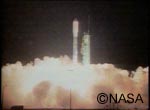Topics
May, 2002
May 7, 2002
Aqua was successfully launched

NASA's Earth observation satellite "Aqua" (formerly named EOS-PM), which carries JAXA's microwave radiometer AMSR-E, was successfully launched by a Delta II rocket at 2:54:58 (PDT) on May 4, 2002, from the Vandenberg Launch Site in California. As scheduled, the Aqua spacecraft successfully separated from the Delta II rocket on its first orbit at 3:54 (PDT), and AMSR-E was powered on at 4:50 (PDT) on May 4.

As suggested by the name "Aqua," Latin for "water," the purpose of the Aqua mission is to collect information about the Earth's water cycle and to investigate its processes. NASA has been conducting the Mission to Planet Earth (MTPE) since 1990 and has contributed to the understanding of the Earth's processes and global climate change. Aqua is a part of the Earth Observing System (EOS) that supports MTPE and is expected to provide practical data for predicting climate change.

The Aqua mission is an international joint project among the US, Brazil, and Japan. JAXA provided the Advanced Microwave Scanning Radiometer for EOS (AMSR-E), the US provided four sensors, and Brazil provided one sensor. Since AMSR-E will provide information on solid water (snow cover, seaice, and snowfall), liquid water (precipitation, seawater, and soil moisture), and gaseous water (water vapor), it is a necessary instrument for achieving Aqua's goals. JAXA's Earth Observation Research Center (EORC) and the AMSR/AMSR-E science team will collaborate on AMSR-E data validation and research using AMSR-E products.
AMSR-E products will be distributed to general users after product accuracy is evaluated.


